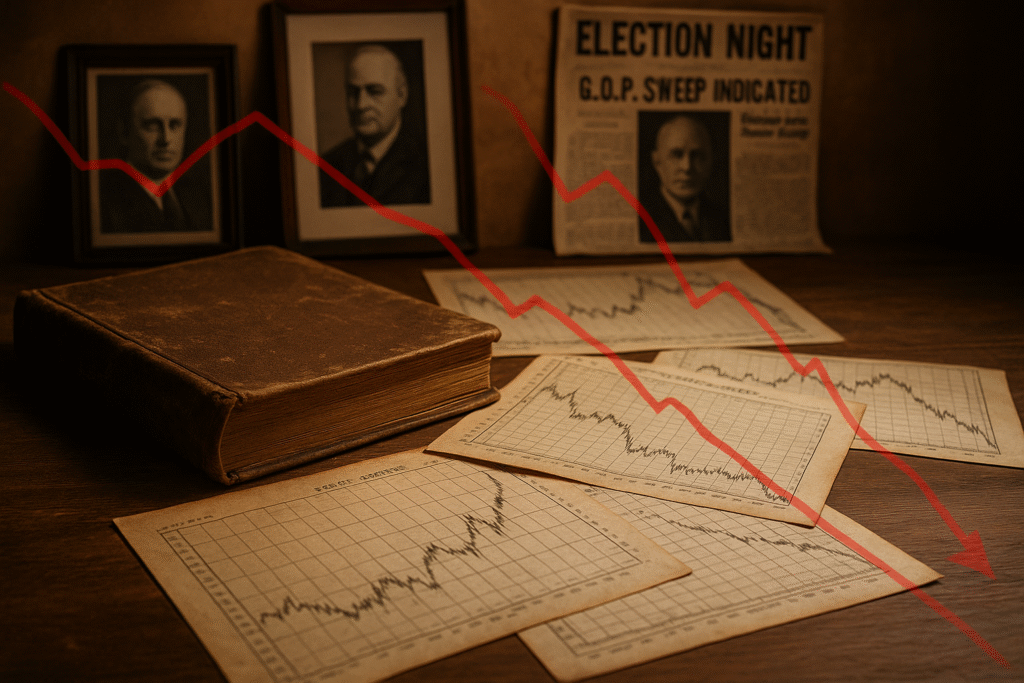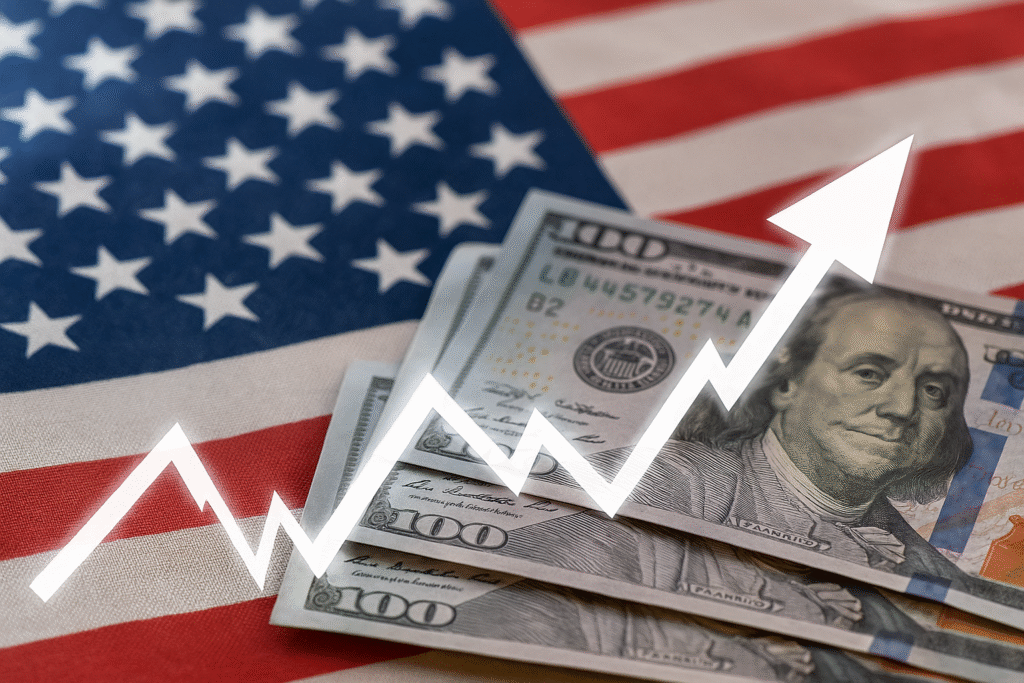Did you watch your portfolio swing wildly after the last election? You’re not alone. A staggering 67% of investors make dramatic portfolio changes based on which party controls Washington—and most end up regretting it. That’s why smart investors avoid politics in investing altogether, focusing instead on fundamentals, diversification, and long-term discipline.
Here’s the truth no one wants to admit: politics and smart investing mix about as well as oil and water.
When you let political bias drive investment strategies, you’re essentially gambling, not investing. The market doesn’t care who you voted for, and data shows politics-based investing decisions consistently underperform the market by about 4% annually.
By the end of this post, you’ll understand exactly why the most successful investors ignore the political noise—and how you can join their ranks. But first, let me show you the shocking pattern that emerges when we look at market returns during “red” versus “blue” administrations. (Spoiler: Politics-based investing rarely pays off—this Barron’s analysis breaks it down brilliantly.)
The Emotional Trap: How Politics Clouds Investment Judgment

Understanding Cognitive Biases in Political-Based Investing
Politics and money don’t mix well. I see this all the time with otherwise smart investors who let their political views hijack their financial decisions.
Here’s the raw truth: your brain plays tricks on you when politics enters the investment equation. That favorite cognitive bias? Partisan bias. It makes you see economic data, market trends, and company performance through red or blue-tinted glasses. This is exactly why seasoned investors avoid politics in investing—because emotional bias is the enemy of rational decision-making.
Picture this: A Democrat might avoid investing in oil companies because of environmental concerns, missing major profit opportunities. Meanwhile, a Republican might load up on defense stocks anticipating policy shifts that never materialize.
The worst part? These biases operate mostly below our conscious awareness. You think you’re making rational decisions based on data, but you’re actually filtering everything through your political worldview.
Some common political investing biases include:
- Availability bias: Giving too much weight to politically charged news that’s fresh in your mind
- Anchoring: Clinging to political narratives about the economy despite contradicting evidence
- Overconfidence: Believing your political insights give you an edge in predicting market moves
Smart investors recognize these mental traps and actively work to counteract them. They separate their political identity from their investment process.
The Confirmation Trap: Seeking Only Information That Aligns With Political Views
We all want to be right. It feels good. That’s why we naturally gravitate toward news sources, financial analyses, and investment advice that confirm what we already believe politically.
This is confirmation bias in action, and it’s poison for your portfolio.
Think about your media diet. If you’re conservative, you probably consume financial news that paints Republican policies as market-friendly and Democratic ones as destructive. If you’re liberal, you likely follow sources that highlight the economic benefits of progressive policies and the dangers of conservative approaches. Either way, letting partisan narratives shape your financial decisions is risky—which is why smart investors consistently avoid politics in investing to stay focused on objective, data-driven strategy.
The problem? You end up in an echo chamber that distorts market reality.
I’ve watched investors:
- Skip right past research that contradicts their political narrative
- Dismiss valid economic indicators that don’t fit their worldview
- Favor anecdotal evidence that supports their political team
What makes this trap so dangerous is how selective perception works. Your brain literally filters information, making you more likely to notice and remember facts that align with your existing beliefs.
Breaking free requires intentionally seeking diverse perspectives. Follow analysts across the political spectrum. Read economic papers that challenge your assumptions. Consider the strongest arguments against your position.
Remember: The market doesn’t care about your political team. It responds to supply, demand, innovation, and countless other factors beyond partisan politics.
How Emotional Decisions Lead to Suboptimal Returns
Politics triggers emotions. That’s just how it works. And emotions are portfolio killers.
When you mix political feelings with investment decisions, you’re setting yourself up for trouble. Fear, anger, hope, and pride all cloud judgment and push you toward impulsive moves.
I’ve seen normally disciplined investors throw their carefully crafted strategies out the window based on election results or congressional votes. They panic-sell after their candidate loses or make overly optimistic bets when “their team” wins.
The data backs this up. Portfolios with high turnover during politically charged periods typically underperform more stable ones. Why? Because emotionally-driven trades often mean:
- Selling low (fear response)
- Buying high (excitement response)
- Overtrading (anxiety response)
- Poor diversification (tribal response)
Your political emotions create a roller coaster that the rational part of your brain struggles to override. You make decisions based on how you want the world to work rather than how it actually works. To protect your portfolio from this trap, it’s essential to avoid politics in investing and stay grounded in evidence-based strategy.
The solution isn’t becoming emotionless—that’s impossible. Instead, create systems that protect you from your emotions. Automated investments, written investment policies, and cooling-off periods before major decisions can all help.
Real-World Examples of Political Bias Damaging Portfolios
Talk is cheap. Let’s look at real money lost by real investors who couldn’t separate politics from portfolios.
Remember the “Trump Trade” after the 2016 election? Countless liberal investors pulled money out of the market, convinced a crash was imminent. They sat on the sidelines during one of the strongest bull markets in history. Their political prediction cost them significant returns.
The flip side? Conservative investors who went all-in on coal and manufacturing stocks based on campaign promises, only to watch many of these sectors underperform broader indexes.
Fast forward to 2020. Many conservative investors exited the market after Biden’s election, missing out on substantial gains in 2021. Meanwhile, progressive investors who loaded up on green energy stocks based on expected policy shifts saw disappointing performance when legislation stalled.
A particularly painful example comes from a client who liquidated his tech-heavy portfolio before the 2016 election, convinced the market would collapse under Trump. Those same tech stocks he sold went on to double and triple in value over the next four years.
Another client went all-in on gold in 2020, certain that Democratic policies would trigger runaway inflation and currency collapse. While inflation did rise, his gold-heavy portfolio significantly underperformed diversified investments.
The pattern is clear: letting political beliefs drive investment decisions typically leads to poor timing, concentration risk, and missed opportunities—regardless of which side of the aisle you sit on.
Historical Evidence Against Political Investing

A. Market Performance Across Different Administrations: Surprising Patterns
You’d think Republican presidents would be better for your portfolio, right? After all, they’re the “pro-business” party. But the data tells a completely different story.
Looking at market returns since 1945, Democratic presidencies have actually delivered higher average annual returns than Republican ones. And we’re not talking about a small difference—it’s substantial.
| Administration Type | Average Annual S&P 500 Return |
|---|---|
| Democratic | 10.8% |
| Republican | 5.6% |
But here’s the kicker—this doesn’t mean you should invest based on which party controls the White House. The timing of economic cycles, global events, and technological breakthroughs have far more impact than whoever sits in the Oval Office. That’s why the smartest approach is to avoid politics in investing and focus on factors that truly move markets.
Take the Clinton years—massive returns during the dot-com boom. Was that because of Clinton’s policies? Or because we happened to be experiencing the birth of the internet economy? You know the answer.
B. Case Studies of Failed Political Investment Strategies
Remember the “Trump Trade” of 2016? Investors piled into infrastructure, financials, and defense stocks, expecting massive deregulation and spending. Some of these bets paid off initially, but many fizzled out spectacularly.
Or how about the investors who fled the market when Obama was elected in 2008, fearing his “socialist” policies would tank stocks? They missed out on one of the longest bull runs in history—a 182% gain in the S&P 500 during his tenure.
Then there’s the “Biden Bust” that never happened. Many predicted green energy would soar while traditional energy would collapse under new regulations. Instead, traditional energy stocks have delivered some of the best returns since 2021.
Political investment strategies fail because they oversimplify complex market dynamics. They ignore the fact that presidents have limited control over the economy and often face unexpected global challenges that completely change their agenda.
C. Why Markets Often Defy Political Expectations
The disconnect between political predictions and market reality boils down to a few key factors.
First, markets are forward-looking while politics is reactive. By the time legislation passes, markets have already priced in the anticipated effects—and sometimes overshot.
Second, businesses adapt. When new regulations come down, companies find ways to work within them, often discovering new profit opportunities in the process.
Third, the global nature of today’s economy means domestic politics has less impact than ever. When 40-50% of S&P 500 revenue comes from overseas, U.S. politics is just one factor among many.
Most importantly, markets care about one thing above all: certainty. Once election results are settled, markets typically rally regardless of who won. It’s the uncertainty leading up to elections that creates volatility, not the actual outcome. This is yet another reason to avoid politics in investing—because chasing predictions adds unnecessary risk without meaningful reward.
The most successful investors know this. They stay focused on company fundamentals, economic data, and long-term trends—not the political drama dominating the headlines.
The Unpredictability Factor: Why Political Outcomes Are Poor Investment Guides

The Disconnect Between Policy Promises and Implementation
You’ve heard politicians make grand promises about economic revolutions. “Vote for me, and watch your investments soar!” But here’s the reality check – what candidates promise rarely matches what they actually deliver once in office.
Remember the 2016 election? Many investors frantically repositioned their portfolios based on campaign rhetoric. Some dumped renewable energy stocks and loaded up on coal and oil. Others did exactly the opposite. Both groups learned a painful lesson.
Why does this happen? For starters, our political system has checks and balances specifically designed to slow down dramatic change. A president might promise sweeping tax reforms, but Congress has different ideas. What starts as a revolutionary proposal often ends up watered down to incremental change – if it happens at all.
Just look at these examples:
| Campaign Promise | What Actually Happened |
|---|---|
| “Repeal and replace” healthcare | Minor adjustments to existing system |
| “Historic tax overhaul” | Temporary tax changes with mixed impact |
| “Infrastructure revolution” | Limited funding for select projects |
By the time a policy makes it through the legislative gauntlet, it’s often unrecognizable from its campaign version. That makes betting your financial future on campaign promises about as reliable as weather forecasts for next year’s summer vacation.
Markets vs. Politics: Different Timeframes and Priorities
Politicians think in election cycles. Markets think in quarters, years, and decades – all at once.
This fundamental mismatch creates major problems for politically-driven investment strategies. While you’re focused on who’s winning the latest debate, the market is processing thousands of other variables simultaneously.
Think about it: when a CEO announces quarterly earnings, the market reacts in seconds. When a politician announces a policy initiative, it might take years to implement – if ever. By the time that policy actually affects corporate earnings, the market has usually priced in those expectations long ago.
Financial markets operate on a completely different clock than political cycles:
| Political Timeline | Market Timeline |
|---|---|
| 2-4 year election cycles | Daily, quarterly, annual, and decade-long cycles simultaneously |
| Focus on next polling numbers | Focus on future earnings potential |
| Reactive to public opinion | Forward-looking price discovery |
| Geographical boundaries | Global interconnections |
Savvy investors understand this disconnect. They know that by the time a political event makes headlines, the real money-making opportunity has typically already passed. The market isn’t waiting for election results – it’s already pricing in multiple possible scenarios and their probability-weighted outcomes.
The Complex Web of Global Influences Beyond Domestic Politics
Think domestic politics drives markets? That’s like believing your local weather is determined solely by your city council.
Markets today respond to an incredibly complex web of global factors that dwarf any single country’s political drama. While you’re obsessing over the latest congressional hearing, trillions of dollars are flowing across borders based on variables most political pundits never discuss. This global complexity is exactly why savvy investors avoid politics in investing and focus instead on broader economic signals and diversified strategy.
Just consider these non-political factors that routinely overwhelm political influences:
- Central bank policies and interest rate decisions
- Technological disruption across industries
- Demographic shifts affecting consumer behavior
- Supply chain innovations
- Energy price fluctuations
- Currency exchange dynamics
- Natural disasters and weather patterns
Need proof? During intense political uncertainty following Brexit and the 2016 US election, markets initially reacted sharply – then quickly resumed their focus on fundamentals like corporate earnings and economic growth. While cable news spent months dissecting political implications, markets moved on within days.
The companies in your investment portfolio operate globally. They’re navigating regulatory environments across dozens of countries simultaneously. What happens in a Chinese factory or an Indian tech hub often matters more to their bottom line than who sits in the White House or which party controls Congress. A Bogleheads discussion reinforces this idea, emphasizing how long-term investing transcends U.S. political shifts.
Why Even Expert Political Forecasters Fail at Market Timing
Political experts get politics wrong. Market experts get markets wrong. Combining these two forms of prediction creates a perfect storm of error.
Political forecasting is notoriously difficult – just ask anyone who confidently predicted election outcomes in 2016 or 2020. Now add the challenge of predicting how markets will interpret those outcomes. You’re essentially multiplying two probability problems together, making your chances of success astronomically small.
Studies consistently show that professional political forecasters perform barely better than chance when predicting election outcomes. And when these same experts try to connect those predictions to market movements, their track record gets even worse.
Consider the investment advice from political pundits before recent elections:
| Election | Common Political Investment Advice | What Actually Happened |
|---|---|---|
| 2016 | “Markets will crash if Trump wins” | Markets rallied significantly |
| 2020 | “Blue wave will hurt certain sectors” | Most sectors performed well regardless |
| 2022 Midterms | “Gridlock is good for markets” | Market moves driven by inflation data instead |
The fundamental problem? Political experts focus on the politics, not the myriad other factors driving markets. They might correctly predict who wins an election but completely misread how markets will process that information in the context of everything else happening globally.
Even when they get the political outcome right, they’re usually wrong about the market’s reaction. That’s because markets don’t simply react to events – they anticipate, adjust, and look beyond them. As this Raymond James article explains, keeping politics out of your portfolio is key to avoiding costly missteps based on short-term sentiment.
Data-Driven Alternatives to Political Investing

Data-Driven Alternatives to Political Investing
A. Fundamentals-Based Strategies That Outperform Political Guesswork
Politics might grab headlines, but company fundamentals drive actual returns. Smart investors know this secret. They focus on cash flow, earnings growth, and balance sheet strength instead of trying to guess which party will win the next election.
Look at companies like Apple, Microsoft, and Amazon. They’ve thrived under both Democratic and Republican administrations because their success depends on product innovation and market dominance—not who sits in the Oval Office. This reinforces why it’s smarter to avoid politics in investing and align your strategy with business fundamentals, not political headlines.
When you dive into financial statements rather than political statements, you’re playing a completely different game. You’re analyzing what truly matters:
- Revenue growth trends
- Profit margin expansion
- Return on invested capital
- Debt-to-equity ratios
- Free cash flow generation
These metrics tell you far more about a stock’s potential than any political forecast ever could.
B. The Power of Diversification Across Political Climates
Playing political favorites with your portfolio is like putting all your eggs in one very unpredictable basket. Smart investors spread their bets across sectors that thrive in different political environments.
Think about it this way: if you had invested exclusively in “Trump stocks” after 2016, you would have missed massive gains in renewable energy under Biden. If you went all-in on “Biden stocks,” you might have missed defense stock rallies during recent geopolitical tensions.
True diversification means owning:
- Growth and value stocks
- Small caps and large caps
- Domestic and international equities
- Traditional and alternative assets
This approach creates an all-weather portfolio that can weather any political storm. When one sector suffers from policy headwinds, another benefits from tailwinds.
C. Long-Term Investment Approaches That Transcend Election Cycles
The average presidency lasts 4-8 years. The average bull market? About 6 years. The average bear market? Around 1.3 years.
See the mismatch?
Political cycles are too short-term for serious wealth building. That’s why investors who take the long view consistently outperform those who jump in and out based on election results.
Warren Buffett famously said, “The stock market is a device for transferring money from the impatient to the patient.” He’s built his fortune by holding quality companies through multiple administrations of both parties. As noted in this Fool Wealth insight, enduring market success comes from patience and perspective—not political speculation.
Consider this: $10,000 invested in the S&P 500 in 1980 would be worth over $760,000 today—spanning six Republican and five Democratic presidential terms. The key wasn’t predicting elections but staying invested through them all.
D. Evidence-Based Metrics That Actually Matter to Returns
Political pundits make predictions. Successful investors rely on evidence.
Research consistently shows that certain metrics correlate strongly with future returns, regardless of which party controls Washington:
| Metric | Why It Matters |
|---|---|
| Price-to-earnings ratio | Lower P/E stocks historically outperform higher P/E stocks |
| Earnings yield | Higher yields typically indicate better value |
| Dividend growth rate | Companies that grow dividends tend to outperform |
| Quality of management | Good leadership navigates any political environment |
| Economic moats | Competitive advantages protect profits regardless of policy |
These factors have demonstrated predictive power across decades of market data—unlike political forecasting, which has a dismal track record of predicting market outcomes.
E. Sector-Neutral Strategies for Political Volatility
Smart investors don’t try to time political shifts—they build portfolios that can handle them.
Sector-neutral strategies maintain balanced exposure across economic sectors, preventing overconcentration in politically sensitive industries. This approach helps avoid politics in investing by neutralizing political risk, while still allowing for smart security selection within each sector.
For example, instead of betting heavily on healthcare stocks because you think healthcare reform will pass (or fail), a sector-neutral approach would:
- Maintain healthcare exposure near market weight
- Select the strongest healthcare companies regardless of policy predictions
- Focus on companies with pricing power and operational efficiency
This strategy acknowledges a simple truth: even sector experts struggle to predict how specific policies will affect individual stocks. By staying sector-neutral, you remove a major source of uncompensated risk from your portfolio.
The bottom line? Political noise creates market inefficiencies that disciplined, evidence-based investors can exploit—not by guessing political outcomes, but by focusing on what truly drives returns while others get distracted.
Building a Politics-Proof Investment Strategy
Creating a Principles-Based Investment Framework
Money and politics are like oil and water – they don’t mix well. Smart investors build their strategies on timeless principles, not political whims. As this Data Insights article puts it: one of the cardinal rules of investing is to ignore politics—and for good reason.
Start by defining your core investment principles. These might include:
- Risk tolerance levels that match your personality (not your political views)
- Time horizons based on your life goals
- Diversification across sectors, not just the ones your political group favors
- Evidence-based asset allocation
Think about Warren Buffett – his approach hasn’t changed with each administration. His core principles of value investing have remained consistent through Democratic and Republican presidencies alike.
Your framework should answer questions like:
- “What return do I need to achieve my goals?”
- “How much volatility can I handle without selling at the worst time?”
- “What investment approach aligns with my long-term objectives?”
Notice how none of these questions involve which party controls Congress?
Tools for Recognizing and Neutralizing Your Own Political Biases
We all have blind spots. The trick is spotting them before they wreck your portfolio.
Try these practical exercises:
The Opposite Test: Before making an investment, ask “Would I make this same decision if my political views were reversed?”
Confirmation Audit: Review your news sources. If they all lean the same way politically, you’re living in an echo chamber.
Data-First Analysis: Force yourself to look at raw numbers before forming opinions. Check economic indicators directly from sources like FRED or BLS.
Devil’s Advocate Journaling: Write down the strongest argument against your investment thesis. If you can’t do this convincingly, you haven’t thought it through.
Portfolio Diversity Check: Does your portfolio accidentally mirror your political beliefs? Many conservatives over allocate to energy and defense, while progressives might pile into clean tech and ESG funds.
When to Ignore the News Cycle (And When to Pay Attention)
The 24-hour news cycle is designed to keep you glued to the screen, not to help you invest wisely. As this Kayne Anderson insight explains, tuning out the media noise is essential for maintaining a clear, rational investment perspective.
When to tune out:
- During election season hyperbole
- When pundits make apocalyptic predictions about minor policy changes
- When headlines use words like “soaring,” “plunging,” or “chaos”
- During manufactured political controversies
When to pay attention:
- Major regulatory changes affecting specific industries
- Significant shifts in tax policy that might impact corporate earnings
- Geopolitical events with concrete economic consequences
- Central bank policy decisions
Remember this: most political “crises” that dominate the news have minimal long-term market impact. The market has grown under both parties over time, which is exactly why long-term investors avoid politics in investing and stay focused on enduring trends, not temporary noise.
Implementing Systematic Rules to Prevent Emotional Decision-Making
Emotions and investing mix about as well as texting and driving. Here’s how to create guardrails:
Automate regular contributions – Set up transfers that happen without your input
Create a personal investment policy statement – Document your rules before you need them
Implement “cooling off” periods – Wait 72 hours before acting on any politically-motivated investment idea
Set rebalancing schedules – Calendar-based or percentage-based triggers that force you to buy low and sell high
Establish decision thresholds – “I will only change my allocation if X economic indicator moves by Y%”
Use dollar-cost averaging – Especially during politically volatile periods
Create an accountability partner – Someone who will call you out when politics is influencing your investment thinking
These systems work because they take decision-making power away from your emotional brain during times of political stress. When everyone else is panicking about the latest Washington drama, your autopilot systems keep you on course.
Conclusion

The intersection of politics and investing creates a dangerous environment where emotional biases, historical misconceptions, and unpredictable outcomes can severely damage your portfolio performance. Research consistently shows that political predictions fail as reliable investment guides, while data-driven strategies focusing on fundamentals, diversification, and long-term planning consistently outperform politically motivated investment decisions.
As markets continue to evolve and political landscapes shift, the wisest approach remains building a politics-proof investment strategy. By focusing on your personal financial goals, maintaining disciplined asset allocation, and making decisions based on economic data rather than political headlines, you position yourself for long-term success regardless of which party controls Washington. The most successful investors avoid politics in investing because they know it’s not about predicting who wins elections—it’s about implementing time-tested principles that thrive across all political environments. The Investillect blog has even more strategies to level up your financial game.

